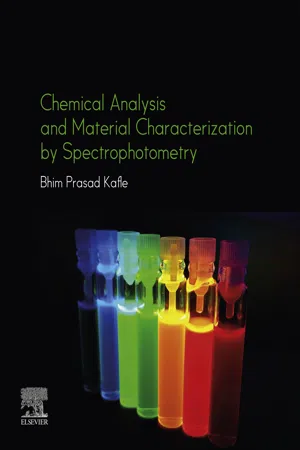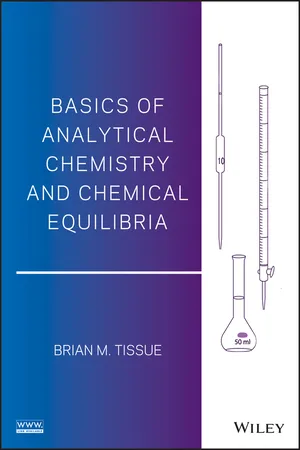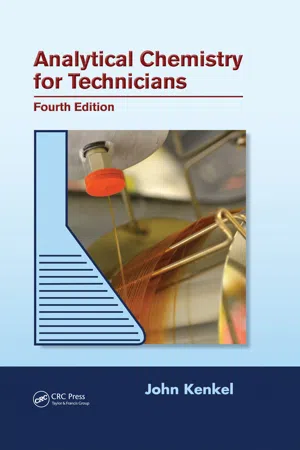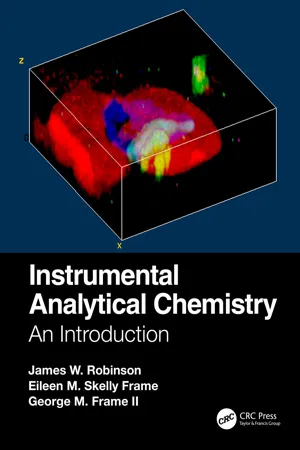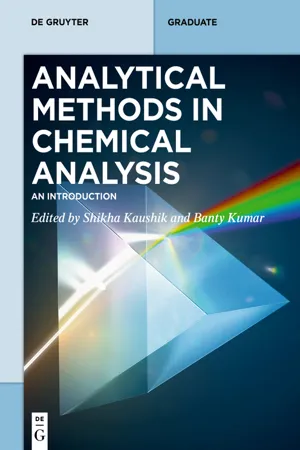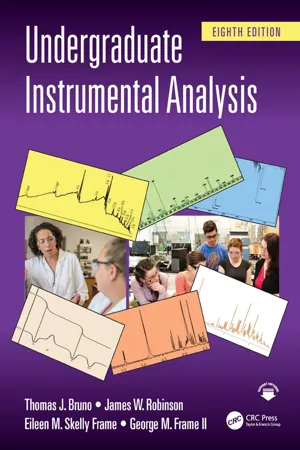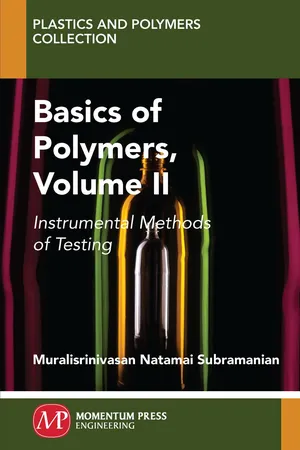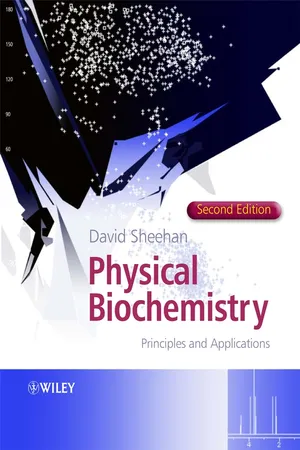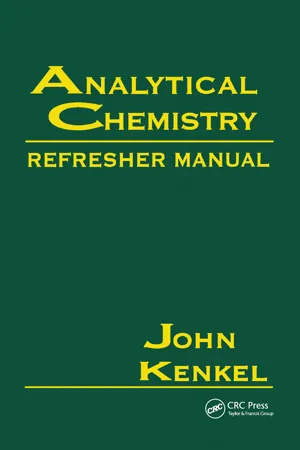Chemistry
Spectroscopy
Spectroscopy is the study of the interaction between matter and electromagnetic radiation. It involves analyzing the way in which different substances absorb or emit light at various wavelengths. By examining these interactions, spectroscopy can provide valuable information about the composition, structure, and properties of substances, making it a powerful tool in chemical analysis and research.
Written by Perlego with AI-assistance
Related key terms
12 Key excerpts on "Spectroscopy"
- Bhim Prasad Kaflé(Author)
- 2019(Publication Date)
- Elsevier(Publisher)
Chapter 1Spectrophotometry and its application in chemical analysis
Abstract
In this chapter, we will learn the types of spectrophotometric techniques and their application for qualitative and quantitative determination of an analyte in a given sample. As a spectroscopic technique concerns with the interaction of light with matter, we will also discuss the properties of light and processes (phenomena) that occur after interaction with matter.Keywords
Electromagnetic radiation; Absorption; Reflection and transmittance; Analyte1.1. Spectroscopy and applications (overview)
Spectroscopy is a branch of science (analytical chemistry) which deals with the study of the interaction of electromagnetic radiation with matter. In fact, traditionally, the interactions of analyte were between matter and electromagnetic radiation, but now Spectroscopy has been broadened to include interactions between matter and other forms of energy. Such examples include beams of particles such as ions and electrons. These kinds of analytical methods that are considered to be one of the most powerful tools available for the study of materials’ fundamental properties (e.g., atomic and molecular structure, optical properties) and also used in quantifying the wide range of chemical species prevailing in a given sample. In this method, an analyst carries out measurements of light (or light-induced charged particles) that is absorbed, emitted, reflected or scattered by an analyte chemical or a material. Then these measured data are correlated to identify and quantify the chemical species present in that analyte. Ideally, a spectrometer makes measurements either by scanning a spectrum (point by point) or by simultaneous monitoring several positions in a spectrum; the quantity that is measured is a function of radiant power.Specifically, over all the other analytical methods, the spectroscopic techniques possess the following advantages:- 1. These techniques are less time consuming and much more rapid.
- No longer available |Learn more
- Brian M. Tissue(Author)
- 2013(Publication Date)
- Wiley(Publisher)
Using electromagnetic (EM) radiation is one of only a few general strategies that we have for detecting and quantitating analytes (see Chapter 1). Having said that, there are many different types of spectroscopic techniques that scientists use to study matter. In this text we discuss only a few—those that are most useful for quantitative analysis.Spectroscopy is the use of EM radiation or charged particles to study the structure (qualitative analysis) or composition (quantitative analysis) of matter. Spectrometry is a synonym, although usually signifying a quantitative measurement. This definition is a bit too broad, but because there are so many spectroscopic techniques throughout the EM spectrum, it is easier to be broad and exclude related scientific tools than to try to formulate a precise but overly long definition. Two areas that this definition includes, which are not spectroscopic methods, are microscopy and diffraction. Microscopy uses EM radiation or electrons to form an image to study the morphology of a sample. Diffraction uses the interference of EM radiation or electrons to determine the atomic structure of molecules or materials. Microscopy and diffraction are not spectroscopic methods, but Spectroscopy is often performed in conjunction with these methods. Two examples are the fluorescence microscope and the energy-dispersive X-ray Spectroscopy, which is performed using an electron microscope to measure elemental composition. We discuss spectroscopic transitions in detail in Section 4.4, but for now keep in mind that Spectroscopy is useful for analytical measurements because we can measure the change in EM radiation when analytes absorb, emit, or scatter the radiation.4.2 Properties Of EM Radiation
EM radiation is composed of individual units of energy called photons. A photon consists of an electric field component, , and a magnetic field component, , which are perpendicular to each other and to the direction of propagation. The electric and magnetic fields oscillate in time at a fixed frequency, , the Greek letter “nu”. The unit of frequency is oscillations per second, , which is also called hertz, Hz. Figure 4.1 shows a schematic to visualize how the and fields oscillate as the photon travels some distance, indicated by the dashed line. The vertical arrows show the magnitude of and the horizontal arrows show the magnitude of . The total distance along the direction of propagation shown in the figure corresponds to one complete cycle of the oscillation of the and fields. We call this distance one wavelength with the symbol - eBook - ePub
- John Kenkel(Author)
- 2013(Publication Date)
- CRC Press(Publisher)
7 Introduction to Spectrochemical Methods7.1 Introduction
Many instrumental methods of analysis involve the refraction, absorption, or emission of light. These can be referred to as spectrochemical methods . The science that deals with the refraction of light is called refractometry and the instrument used is called the refractometer . The science that deals with the absorption and emission of light is called Spectroscopy or spectrometry . The broad term for the instruments used is spectrometer , whereas a slightly more specific term (when a light sensor known as a phototube is used) is spectrophotometer . In spectrochemical analysis procedures, the degree to which light is refracted or absorbed, or the intensity of light that is emitted, is related to the amount of an analyte present in the sample tested. Thus, the degree of light refraction, absorption, and the intensity of light emission are the critical measurements. The electrical signal readout referred to in Figure 6.2 is an electrical signal that is related to the degree of light refraction, absorption or the intensity of light emission. The instrument readings mentioned in Figure 6.3 are the readings generated by the instrument as a result of this refraction, absorption, or emission (see Figure 7.1 ).In this chapter, we expand the above brief summary so that all aspects of refractometry and Spectroscopy as analytical methods can be clearly understood and practiced. This will mean providing a full discussion of the nature and parameters of light, including energy, wavelength, frequency, and wavenumber. We will address exactly what is meant by light refraction, absorption, and emission. The discussion includes the spectral differences between atoms (atomic Spectroscopy ) and molecules (molecular Spectroscopy - eBook - ePub
Instrumental Analytical Chemistry
An Introduction
- James W. Robinson, Eileen M. Skelly Frame, George M. Frame II(Authors)
- 2021(Publication Date)
- CRC Press(Publisher)
However, matter composed of molecules, atoms, or ions, which exists as solid or liquid or gas, exhibits primarily the properties of particles. Spectroscopy studies the interaction of light with matter defined as materials composed of molecules or atoms or ions. In a gas, atoms or molecules are widely separated from each other; in liquids and solids, the atoms or molecules are closely associated. In solids, the atoms or molecules may be arranged in a highly ordered array, called a crystal, as they are in many minerals, or they may be randomly arranged, or amorphous, as they are in many plastics. Atoms, molecules, and ions are in constant motion whatever their physical state or arrangement. For molecules, many types of motion are involved. Molecules can rotate, vibrate, and translate (move from place to place in space). Interaction with radiant energy can affect these molecular motions. Molecules that absorb IR radiation vibrate with greater amplitude; interaction with UV or visible light can move bonding electrons to higher energy levels in molecules. A change in any form of motion or electron energy level involves a change in the energy of the molecule. Such a change in energy is called a transition ; we have the possibility of vibrational, rotational, and electronic transitions in molecules. We have some of the same kinds of motion in atoms and ions. Atoms can move in space, and their electrons can move between energy levels, but atoms and monoatomic ions cannot rotate or vibrate. The chemical nature of matter (its composition), its physical state, and the arrangement of the atoms or molecules in the physical state with respect to each other affect the way in which any given material interacts with electromagnetic radiation. Table 2.2 lists some of the important types of transitions studied by Spectroscopy. We will cover these techniques in detail in later chapters. There are many types of transitions and types of Spectroscopy used to investigate matter - eBook - ePub
Analytical Methods in Chemical Analysis
An Introduction
- Shikha Kaushik, Banty Kumar, Shikha Kaushik, Banty Kumar, Shikha Kaushik, Banty Kumar(Authors)
- 2023(Publication Date)
- De Gruyter(Publisher)
Section III: Spectrochemical methods of analysisChapter 4 UV–visible Spectroscopy
Neeta AzadAbstract
Spectroscopy is one of the important techniques used for the structural analysis of compounds, and it finds its application in all fields of science like Chemistry, Biochemistry, Biology, and Medicines. Spectroscopy deals with the interaction of matter with electromagnetic radiations (EMR). EMR can be categorized into different regions on the basis of their frequencies/wavelengths, and these are gamma rays (γ, highest frequency/lowest wavelength), X-rays, ultraviolet–visible (UV–vis), infrared (IR), microwaves, and radio waves (lowest frequency/longest wavelength). The characteristics of radiations associated with different EM regions are completely different due to their frequencies, as frequency is the measures of energy associated with the EMR. This chapter focuses on UV–visible region of the EM spectrum which falls in wavelength region from 190 to 800 nm. The interaction of matter with radiations in UV–visible region shows wide applicability in our daily life; for example, characterization of colors is done on the basis of their wavelength. Everything around us looks colorful because of visible light. In chemical analysis of compounds, the different color of solutions refers to different concentrations. Similarly, in case of conjugated organic compounds, electronic transitions between various energy states are responsible for their UV–visible spectra. This phenomenon can be studied using Beer–Lambert’s law, which signifies the relation between absorbance of radiations in UV–visible region and concentration of solution under study.The prime concern of this chapter is to present concepts of UV–visible Spectroscopy in a very simple manner, which can be easily understood by undergraduate students. EM spectrum along with the importance of UV–visible region has been discussed in detail with simple examples so that students can correlate the concepts with their daily life. The highlights of this chapter are properties of EMR, origin of spectra, interaction of radiations with matter, and fundamental laws of Spectroscopy. After reading this chapter, questions like how absorption and emission of EMR give rise to emission and absorption Spectroscopy, and how these two are different, can be answered. Along with the explanation of role of transmittance and absorbance in Beer–Lambert’s law, its mathematical treatment has also been elaborated. Important terms and symbols used in absorption measurements and basic principles of instrumentation (choice of source, monochromator, and detector) for single and double beam instrument have also been taken into consideration so that one can apply these concepts while working in laboratory. What are the important instrumental techniques of recording UV–visible spectrum and how to analyze the recorded spectrum? What kinds of compounds are active in UV and visible range? All these concepts are summed up in this chapter. - eBook - ePub
- Thomas J. Bruno, James W. Robinson, George M. Frame II, Eileen M. Skelly Frame(Authors)
- 2023(Publication Date)
- CRC Press(Publisher)
CHAPTER 3 Introduction to SpectroscopyDOI: 10.1201/9781003188544-33.1 INTERACTION BETWEEN ELECTROMAGNETIC RADIATION AND MATTER
We know from our observation of rainbows that visible light (white light) is composed of a continuum of colors from violet to red. If a beam of white light is passed through a beaker of water, it remains white. If potassium permanganate is added to the water, the white light appears purple after it passes through the solution. The permanganate solution allows the red and blue components of white light to pass through but absorbs the other colors from the original beam of light. This is one example of the interaction of electromagnetic radiation, or light, with matter. In this case, the electromagnetic radiation is visible light and we can see the effect of absorption of some of the light with our eyes. However, interactions between electromagnetic radiation and matter take place in many ways and over a wide range of radiant energies. Most of these interactions are not visible to the human eye but can be measured with suitable instruments.The interaction of electromagnetic radiation and matter is not haphazard but follows well-documented rules with respect to the wavelengths of light absorbed or emitted and the extent of absorption or emission. The subject of Spectroscopy is the study of the interaction of electromagnetic radiation and matter.3.1.1 What Is Electromagnetic Radiation?
The nature of electromagnetic radiation baffled scientists for many years. At times, light appears to behave like a wave; at other times, it behaves as though it were composed of small particles. While we now understand the “wave–particle duality” of all matter, including electromagnetic radiation, in terms of quantum mechanics, it is still convenient to consider electromagnetic radiation as having the properties of waves in many cases.Light waves can be represented as oscillating perpendicular electric and magnetic fields. The fields are at right angles to each other and to the direction of propagation of the light. The oscillations are sinusoidal in shape, as shown in Figure 3.1 . We can easily and accurately measure the wavelength λ defined as the crest-to-crest distance between two successive maxima. The standard unit of wavelength is the SI unit of length, the meter (m), but smaller units such as centimeter (cm), micrometer (μm), and nanometer (nm) are commonly used. The amplitude of the wave is defined as the maximum of the vector from the origin to a point displacement of the oscillation. An example of the electric field portion of a light wave propagating along only one axis is shown in Figure 3.1 . Such a wave, confined to one plane, is called plane-polarized light. The wave shown represents only a single wavelength, λ. Light of only one wavelength is called monochromatic light. Light that consists of more than one wavelength is called polychromatic - eBook - ePub
Introduction to Soil Chemistry
Analysis and Instrumentation
- Alfred R. Conklin, Mark F. Vitha(Authors)
- 2013(Publication Date)
- Wiley(Publisher)
CHAPTER 14 Spectroscopy and Spectrometry14.1 Spectral Overlap14.2 Noise14.3 The Visible Region14.4 Ultraviolet Region14.4.1 Ultraviolet Sample Preparation14.5 Infrared Spectroscopy14.5.1 Infrared Sample Preparation14.6 Nuclear Magnetic Resonance14.6.1 Nuclear Magnetic Resonance Sample Preparation14.7 Mass Spectrometry14.8 Atomic Spectroscopy14.8.1 Excitation for Atomic Emission14.8.2 Atomic Absorption14.9 Color Measurement: The Spectrophotometer14.9.1 Zeroing and Blanks14.9.2 Relating Component Concentration to the Extract14.10 Regression Analysis14.11 Relationship to the Original Sample14.12 X-ray Diffraction14.13 X-ray Fluorescence14.14 Remote Sensing14.15 ConclusionThe electromagnetic spectrum is a continuum of wavelengths, λ, which can also be expressed as frequency (proportional to the reciprocal of wavelength). Within this spectrum, visible light represents a very small part: the region of wavelengths around 10−5 cm. All regions of the electromagnetic spectrum have been used to analyze environmental constituents, including those in soil. In some cases, the radiation is passed through the material being investigated and absorbed frequencies related to the components it contains. In other cases, radiation is reflected or refracted from the sample and information gathered as a result of changes in the radiation occurring during these processes.How electromagnetic radiation is used to investigate the characteristics of a sample depends on how it interacts with matter. X-rays are diffracted by atoms, and so they are used to elucidate the arrangement of atoms in a material, commonly crystals. Absorption of ultraviolet (UV) and visible light results in the movement of electrons from one orbital to another. Electrons in double or triple bonds, nonbonding electron pairs, and electrons in d - eBook - ePub
Basics of Polymers, Volume II
Instrumental Methods of Testing
- Muralisrinivasan Subramanian(Author)
- 2019(Publication Date)
- Momentum Press(Publisher)
Spectroscopic techniques range from ultraviolet to near-infrared waves, which are short in length and measure up to ~1.0 μm. Spectrophotometric analysis, as the science and technology of wavelengths, involves the measurement of relative radiant energy. The energy may come from an emitting source directly or may be transmitted, absorbed, or reflected by absorbing materials. Spectrum denotes the established range of light absorption from the molecule. Spectroscopic techniques can be divided into sample selection, separation, and preparation. In addition, spectroscopic analysis provides detection of group, substance identification, and material quantification.3.2. Fourier TransformFourier transform (FT) eliminates enhanced noisy spectral and chromatographic waveforms. This operation is particularly simple and convenient choice of spectral smoothing approach (Figure 3.1 ). Least squares approximations have been employed in reducing high-frequency random variations in measured signals. FT has become a popular method of enhancing the information content with various instruments.In FT, the lower frequency amplitudes are unaffected, while high-frequency information of characterizing random noise is zeroed. Thereby, the inverse transform yields a smoothened waveform. Figure 3.1 shows the transformation of noise waveform into FT.3.3. Ultraviolet and Visible Absorption SpectroscopyThe absorption of electromagnetic radiation by matter in the domain ranges from the near ultraviolet to the very near infrared, between 180 and 1,100 nm. This portion of the spectrum is designated as UV–VIS, which includes radiation perceptible to the human eye. This Spectroscopy yields little structural information. However, it provides useful information regarding quantitative measurements.The concentration of an analyte in solution can be determined by measuring the absorbance in the spectra at some wavelength and applying the Lambert–Beer law. This method is commonly known as colorimetry. It is considered not only for compounds possessing an absorption spectrum in that spectral region but equally for all those compounds following modification by specific regents, which leads to derivatives and permit absorption measurements. UV spectrometry is used in continuing examination of procedures for determining copolymer composition (Ramelow and Baysal 1986). UV Spectroscopy, with its spectral resolution, is useful in many applications. It identifies the presence of monomer in the polymer (Crippen and Borella 1949; Tobolsky, Eisenberg, and O’Driscoll 1959). The UV−VIS spectra of polyurethane is shown in Figure 3.2 - eBook - ePub
Foundations of Organic Chemistry
Unity and Diversity of Structures, Pathways, and Reactions
- David R. Dalton(Author)
- 2020(Publication Date)
- Wiley(Publisher)
CHAPTER 2 An Introduction to Spectroscopy and Selected Spectroscopic Methods in Organic Chemistry All that we see or seem is but a dream within a dream. —Poe A. GENERAL INTRODUCTION. THE ELECTROMAGNETIC SPECTRUM 1 It might have aided the growth of organic chemistry if advances in the isolation and purification of organic compounds had been coupled with greater progress in methods with which to assign structures. However, in general, the idea of organized structure (or the way in which atoms might be connected to each other to form molecules) seems to have originally derived from finding materials that had the same elemental composition but different physical properties (these materials are called isomers and several different kinds of isomers will be discussed in Chapter 3). 2 The attempts to actually “see” the cause(s) of the differences were frustrated by the lack of the appropriate tools. As a consequence, structures of molecules were deduced by reactions, and, as challenges due to structural complexity increased because more difficult problems were undertaken, analogies were made to structures that were presumed to be correct. Chemical reactions, which included such processes as oxidation, reduction, and fragmentation (sometimes called degradation) of large molecules into smaller ones, were commonly employed. Frequently, when it was possible to tentatively identify small fragments, imaginative constructs as to how they might be reconnected to form the original molecule were developed. Then, additional reactions to combine fragments (the process called synthesis) so as to actually recreate what had been oxidized, reduced, or fragmented were explored. The results became incorporated into the framework of the science. Eventually, volumes of information on characteristic properties of various kinds of compounds were compiled - eBook - ePub
Physical Biochemistry
Principles and Applications
- David Sheehan(Author)
- 2013(Publication Date)
- Wiley(Publisher)
Chapter 3
Spectroscopic Techniques
Objectives After completing this chapter you should be familiar with:- The Electromagnetic spectrum,
- The concept of transition between energy levels ,
- The variety of spectroscopic techniques available ,
- Applications of spectroscopic techniques in biochemistry .
Electromagnetic radiation spans a wide range of energy levels in a continuum called the electromagnetic spectrum . Each part of this spectrum may be characterized by a specific range of wavelengths . Living organisms are constantly exposed to a wide range of electromagnetic radiation from the Sun or other stars. Man-made sources of radiation include heated filaments of the type found in ordinary light bulbs. We can select for different parts of the electromagnetic spectrum using a prism or similar device. Depending on its energy content, radiation from different parts of the electromagnetic spectrum may interact with biomolecules in a wide variety of ways. Electromagnetic radiation therefore provides a useful means to probe the chemical structure of biomolecules. In this chapter we will look at the electromagnetic spectrum and describe some of the experimental information it is possible to derive from studying interactions between electromagnetic radiation and biomolecules.3.1 THE NATURE OF LIGHT
3.1.1 A Brief History of the Theories of Light
Light is composed of electric and magnetic fields, which are mutually perpendicular and which radiate out from a source in all directions (Figure 3.1 ). It is therefore a form of electromagnetic radiation . A wave description of electromagnetic radiation resulted from the work of Maxwell, Hertz and others in the nineteenth century. In this description, electric and magnetic fields are propagated through space as wave functions which may be characterized by wavelength, λ (the distance from one part of the wave to the corresponding position on the next wave) and frequency, ν (the number of times a wave passes through a fixed point in space every second). These parameters are related to the energy content of the wave,E, by Equations (3.1) and (3.2) - eBook - ePub
- John Kenkel(Author)
- 2020(Publication Date)
- CRC Press(Publisher)
HAPTER 6MOLECULAR SPECTROSCOPY6.1 INTRODUCTION
More than half of all instrumental methods of analysis involve the measurement of either light absorption or light emission by a sample. For this reason, the analyst needs to have a basic understanding of the modern theory of light and parameters of light, namely wavelength, frequency, wave number, and energy, as well as the concept of how light interacts with matter and the theory behind the emission and absorption phenomena. This chapter introduces these concepts and continues with perhaps the oldest and some of the most popular of all instrumental analysis techniques, that of ultraviolet, visible, and infrared molecular absorption analysis. The final sections deal with NMR and mass spectrometry.6.1.1 Nature and Parameters of Light
The modern theory of light says that light has a “dual nature.” This means that light exhibits both the properties of waves (the wave theory) and the properties of particles (the particle theory). The wave theory says that light travels from its source via a series of repeating waves, much like waves of water move across the surface of a body of water. The particle theory says that light consists of a stream of particles called “photons” emanating from the source. For our purposes, the wave theory seems to have the most applicability.The one important difference between waves of light and waves of water moving across a body of water is that the light waves are not mechanical waves like water waves. Light waves do not require matter to move or to exist. Rather than being mechanical disturbances, they are electromagnetic disturbances, and as such, they can travel through a vacuum, from the sun to the earth, for example. Since light waves are electromagnetic disturbances, light is often referred to as electromagnetic radiation. It has an electrical component and a magnetic component. Of particular importance in analytical chemistry are the wavelength, frequency, and energy of light as described by the wave theory. - eBook - ePub
- Richard A. Storey, Ingvar Ymén, Richard A. Storey, Ingvar Ymén(Authors)
- 2011(Publication Date)
- Wiley-Blackwell(Publisher)
In the past, physical characterization of the active pharmaceutical ingredient has relied upon optical microscopy, X-ray powder diffraction, and thermal techniques including differential scanning calorimetry and thermogravimetric analysis. In the 1940s, infrared Spectroscopy became another technique utilized in the multidisciplinary approach to the physical characterization of pharmaceutical solids. More recently, near infrared (NIR), Raman, solid-state nuclear magnetic resonance (NMR) and terahertz (THz) Spectroscopy have been added to the arsenal of techniques for solid-state characterization.The selection and proper application of these analytical techniques for solid state pharmaceutical characterization is dependent on the analytical information required and the physical and chemical nature of the sample. All of these techniques involve measuring the interaction of an external source of radiant electromagnetic (EM) radiation with the sample and the potential to undergo subsequent energy changes. The energy of this EM radiation governs the physicochemical properties of the sample that may be probed. Therefore, it is useful to briefly examine the properties of EM radiation itself.3.2 Electromagnetic RadiationThe electromagnetic spectrum spans the range of energy vibrations of wavelength: several meters to 10−2 nanometres (cosmic rays). It has been demonstrated that EM radiation exhibits both wavelike and particle-like properties. The former may be described using the classical sinusoidal-wave model. Thus EM radiation may be characterized by its wavelength, λ, frequency, v , velocity, c , and amplitude (Figure 3.1 ). The wavelength is the distance between the successive points of equal phase of a wave (e.g. crest to crest) and is equal to the velocity of the wave divided by its frequency (unit: metre, m). In molecular Spectroscopy, wavelength is often more conveniently expressed in either nanometres (nm) or micrometres (μm) (a nanometre is 10−9 m; a micrometre is 10−6 m and was formerly also termed a micron). Frequency, v , is the number of complete wave cycles that occur per second (units: per second, s−1 or Hertz, Hz) (Murray and Williams 1987). The velocity of all electromagnetic radiation, c , is the constant termed the speed of light in a vacuum (c = 2.997 925 108 ms−1
Index pages curate the most relevant extracts from our library of academic textbooks. They’ve been created using an in-house natural language model (NLM), each adding context and meaning to key research topics.
